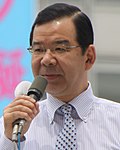
Back Shūgiin-Wahl 2005 German Elecciones generales de Japón de 2005 Spanish Élections législatives japonaises de 2005 French הבחירות הפרלמנטריות ביפן 2005 HE Elezioni parlamentari in Giappone del 2005 Italian 第44回衆議院議員総選挙 Japanese 제44회 일본 중의원 의원 총선거 Korean Wybory parlamentarne w Japonii w 2005 roku Polish 第44屆日本眾議院議員總選舉 Chinese 第44屆日本眾議院議員總選舉 ZH-YUE
| ||||||||||||||||||||||||||||||||||||||||||||||||||||||||||||||||||||||||||||||||||
All 480 seats in the House of Representatives 241 seats needed for a majority | ||||||||||||||||||||||||||||||||||||||||||||||||||||||||||||||||||||||||||||||||||
|---|---|---|---|---|---|---|---|---|---|---|---|---|---|---|---|---|---|---|---|---|---|---|---|---|---|---|---|---|---|---|---|---|---|---|---|---|---|---|---|---|---|---|---|---|---|---|---|---|---|---|---|---|---|---|---|---|---|---|---|---|---|---|---|---|---|---|---|---|---|---|---|---|---|---|---|---|---|---|---|---|---|---|
| Turnout | 67.51% ( 67.46% ( | |||||||||||||||||||||||||||||||||||||||||||||||||||||||||||||||||||||||||||||||||
| ||||||||||||||||||||||||||||||||||||||||||||||||||||||||||||||||||||||||||||||||||
 Districts and PR districts, shaded according to winners' vote strength | ||||||||||||||||||||||||||||||||||||||||||||||||||||||||||||||||||||||||||||||||||
| ||||||||||||||||||||||||||||||||||||||||||||||||||||||||||||||||||||||||||||||||||
| This article is part of a series on |
 |
|---|
|
|
General elections were held in Japan on 11 September 2005 for all 480 seats of the House of Representatives, the lower house of the Diet. Prime Minister Junichiro Koizumi called the election almost two years before the end of the term taken from the previous elections in 2003, after bills to privatize Japan Post were voted down in the upper house (which cannot be dissolved), despite strong opposition from within his own Liberal Democratic Party (LDP).
The elections resulted in a landslide victory for Koizumi's LDP, with the party winning 296 seats, the largest share since World War II, and marked the first time the LDP had won an overall majority in the House of Representatives since 1990. With its partner, New Komeito, the governing coalition then commanded a two-thirds majority in the lower house, allowing them to pass legislative bills over the objections of the upper house and (though the government did not attempt this) to approve amendments to the Constitution, then submit them to the upper house and a national referendum.
The opposition Democratic Party (DPJ), which advocated a change of government during campaign, suffered a devastating loss, winning only 113 seats against the 175 seats it had previously held. The setback led to the resignation of DPJ leader Katsuya Okada and raised fears regarding whether or not the DPJ could remain an alternative to the LDP in future elections.
The small parties made only small gains or losses, with Koizumi's ally, New Komeito, falling slightly from 34 seats to 31. Of the new parties contesting the election, the New Party Japan fell from three seats to one, while the People's New Party was unchanged at four seats. The Japanese Communist Party held its ground with nine seats, while the Social Democratic Party won seven, a gain of one.
Cite error: There are <ref group=lower-alpha> tags or {{efn}} templates on this page, but the references will not show without a {{reflist|group=lower-alpha}} template or {{notelist}} template (see the help page).
© MMXXIII Rich X Search. We shall prevail. All rights reserved. Rich X Search



